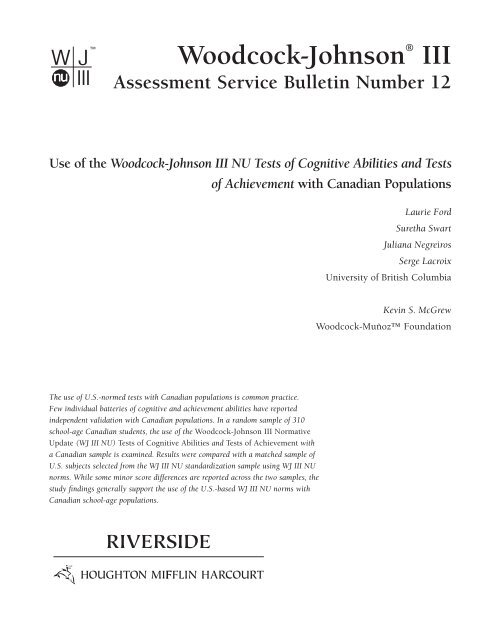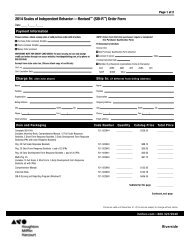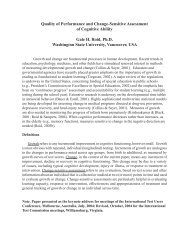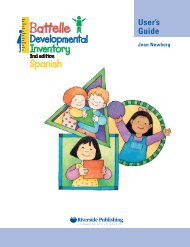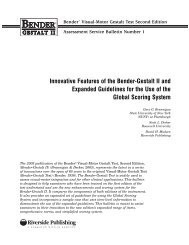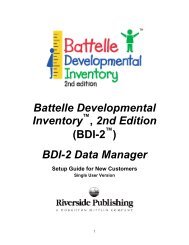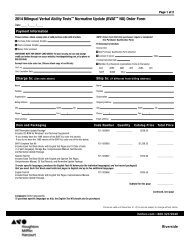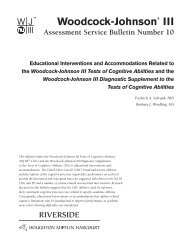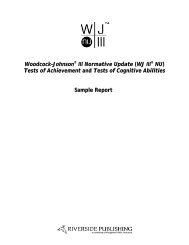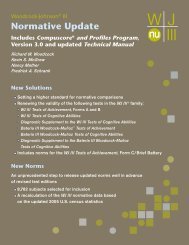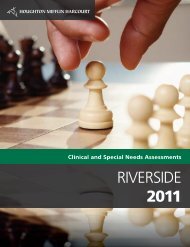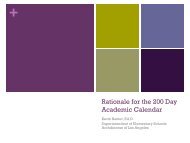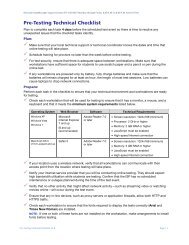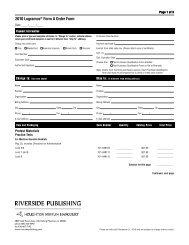Woodcock-Johnson® III - Riverside Publishing
Woodcock-Johnson® III - Riverside Publishing
Woodcock-Johnson® III - Riverside Publishing
- No tags were found...
You also want an ePaper? Increase the reach of your titles
YUMPU automatically turns print PDFs into web optimized ePapers that Google loves.
<strong>III</strong> DS). In addition to the CHC clusters, the complete set of 31 WJ <strong>III</strong> NU cognitive tests(20 in the original WJ <strong>III</strong> cognitive battery plus 11 in the WJ <strong>III</strong> DS) are also organizedby three broader categories related to cognitive performance (Cognitive PerformanceModel [CPM] Clusters): Verbal Ability, Thinking Ability, and Cognitive Efficiencyand five clinical clusters: Broad Attention, Executive Functioning, Working Memory,Cognitive Efficiency, and Phonemic Awareness. The 22 achievement tests are organizedby curricular area (reading, mathematics, written language, and academic knowledge)and oral language and by clusters within these areas (e.g., Basic Reading Skills, MathReasoning), with additional groupings for special purpose clusters (e.g., Academic Skills,Phoneme/Grapheme Knowledge). These batteries have particular diagnostic utilitybecause they encourage examiners to be selective in their testing and select differentevaluation tools based on specific referrals.Like the earlier versions of the WJ, the WJ <strong>III</strong> has been viewed as state of the artin the individual measurement of cognitive abilities and achievement (Cizek, 2003;Cummings, 1995; Hicks & Bolan, 1996; Lee & Stefany, 1995; Standoval, 2003). TheWJ has long been one of the most widely used individually administered academicachievement batteries. Furthermore, the WJ <strong>III</strong> COG is being taught as a primarymeasure of intelligence in over one third of all school psychology training programsacross the United States and Canada (Braden & Alfonzo, 2003; Ford, Percy, & Negreiros,2010). Its strong psychometric properties, the co-normed tests of cognitive abilities andachievement, its utility for use with individuals throughout the lifespan, and featuresthat assist in understanding unique processing strengths and weakness contribute to itsfrequent use in Canada. The widespread use of the WJ <strong>III</strong> NU in the absence of normtransportability research heightens the importance of the current investigation.MethodParticipantsThe study is comprised of two matched samples, one strategically sampled from Canadaand a matched sample of WJ <strong>III</strong> NU standardization subjects obtained from the UnitedStates. This section describes the sample selection and comparison procedures.Canadian SampleThe Canadian sample consisted of 341 English-speaking school-aged children fromthree geographical areas (Western Canada, Central Canada, and Atlantic Canada). Thesampling procedures mirrored those used in the standardization of the WJ <strong>III</strong> (McGrew& <strong>Woodcock</strong>, 2001a). A three-stage procedure of sampling communities, then schools,and finally subjects was used to identify and select a sample that would be broadlyrepresentative of the English-speaking Canadian school-age population. Communitieswere sampled by census region and type of community as defined by Statistics Canada(1996). Participants were obtained from six Provinces (British Columbia, Saskatchewan,Manitoba, Ontario, Prince Edward Island, and Newfoundland). Communities weretargeted for selection within each of the three geographical areas based on geographicdistribution, size of community, and socioeconomic status (SES) characteristics (high,average, and low SES communities). School board participation was then solicitedfrom the targeted communities. When school board participation was not obtained fora targeted community, a similarly matched community from the same geographic area4
was identified and school board participation was subsequently sought. In summary,final inclusion of a community in the sample reflects: a) a targeted community based ongeographical area, community size, and community SES and b) school board agreementto participate in the study.In small communities, testing was conducted in all schools. In larger communities,testing was conducted in a subset of schools. The general guideline for selecting thesubset of schools was to obtain an equal distribution of schools in high versus lowSES areas. This guideline was specified to avoid any potential selection bias. To bestrepresent a cross-section of students in the community, Catholic schools were includedin communities where these schools were available and agreement to participate wasobtained. Thirty-four Catholic schools were included in the study.Sampling of participants was based on a quota-by-grade level criterion. Thesolicitation of subjects was entirely random. The permission forms included subjectidentifying information (e.g., date of birth, grade, sex, and ethnic origin), mother’s andfather’s education level, and mother’s and father’s current occupation. Any subject whohad less than 1 year of experience in an English-only classroom was excluded from thesample.From among the returned permission forms, subjects were selected based on theidentified subject-level variables needed to fill the sampling plan (male versus female,highest grade completed by parents, ethnic origin) and were subsequently tested atschool. Although the total sample was 341 in grades kindergarten through 12, only 310students in grades 1 through 12 were included in the present study due to missing datafrom some tests or clusters. The 310 Canadian children ranged in age from 6 years,8 months to 19 years, 5 months (M = 149.41 months, SD = 40.37) and were closelydistributed by sex (148 males and 162 females).U.S. Matched SampleThe 310 Canadian subjects served as the foundation for the U.S. matched sample thatwas selected from the 8,782 participants in the WJ <strong>III</strong> standardization sample. A U.S.subject that best matched each Canadian subject was selected from the complete WJ <strong>III</strong>standardization sample.Subject matching was based on a hierarchical sequence of matching variables—age(in months), parent education (highest level of either mother’s or father’s education),race/ethnicity (white or nonwhite), and sex. If more than one U.S. subject met thematch criteria, a U.S. subject was randomly selected from the available pool. Althougha concerted effort was made to collect common demographic indicators across thetwo samples, an exact match was not possible, given differences in the way censusinformation and demographic variables are defined in Canada and in the United States.For example, Statistics Canada defines ethnic groups according to ancestry (e.g., British,French or European, Multiple Origins, or Other); the U.S. Census categorizes individualsaccording to race (e.g., White, Black/African-American, American Indian, Asian/PacificIslander) and Hispanic origin (Hispanic or non-Hispanic). The 310 U.S. subjects selectedranged in age from 6 years, 8 months to 19 years, 5 months (M = 149.74 months, SD =40.11) and were closely distributed by sex (150 males and 160 females).A comparison of the two samples on the matching and other variables revealed ahigh degree of comparability. Chi-square analyses revealed no significant differencesin frequencies of subjects in the Canadian and U.S. samples as a function of parent5
6education level (chi-square = 4.56; df = 4.0, p = 0.34), race (chi-square = 0.37; df = 1.0,p = 0.54), or gender (chi-square = 0.03; df = 1.00, p = 0.87). Comparison of the ages(in months) of the Canadian and U.S. samples (t test) revealed no significant difference(M difference = 0.40, t (618) = 0.12, p = 0.90). A similar t-test comparison of gradeplacement in tenth of years (M difference = 0.29, t (618) = 1.09, p = 0.27) also was notsignificant. Comparisons of the distributional characteristics of the two samples alsosuggested strong comparability of the two samples. Summary statistics for the matchingvariables are presented in Table 1.
Table 1.Sample Characteristics (N = 310)N Canadian Percentage N U.S. PercentageSexMale 148 47.7 150 48.4Female 162 52.3 160 51.6Grade1–4 91 29.4 99 31.95–8 105 33.8 112 36.29–12 114 36.8 99 31.9Father’s Education Level< High School Diploma 76 24.5 5 1.6High School Diploma 62 20.0 50 16.1Post Secondary/Diploma 75 24.2 80 25.8University Degree 80 25.8 90 29.1Not Reported 17 5.5 85 27.4Mother’s Education Level< High School Diploma 65 21.0 47 15.2High School Diploma 61 19.7 84 27.1Post Secondary/Diploma 105 33.8 107 34.5University Degree 75 24.2 72 23.2Not Reported 4 1.3 0 0Ethnic OriginWhite/Anglo/European 247 79.7 252 81.3Asian-Pacific Islander 46 14.8 13 4.2First Nations/Aboriginal/Native American 10 3.2 7 2.3Black/African/African American 7 2.3 38 12.2Hispanic a 4 1.3 33 10.6Community SizeCentral Place 89 28.7 81 26.1Urban Fringe 76 24.5 75 24.210,000 to 50,000 38 12.3 73 23.6
InstrumentationCanadian participants in this study were administered selected tests from thestandardization edition of the <strong>Woodcock</strong>-Johnson <strong>III</strong> Tests of Cognitive Abilities (WJ <strong>III</strong>COG) (<strong>Woodcock</strong>, McGrew, & Mather, 2001c) and the <strong>Woodcock</strong>-Johnson <strong>III</strong> Tests ofAchievement (WJ <strong>III</strong> ACH) (<strong>Woodcock</strong>, McGrew, & Mather, 2001b) and the completeWechsler Intelligence Scale for Children–Third Edition (WISC-<strong>III</strong>) (Wechsler, 1991). Onlythe WJ <strong>III</strong> COG tests that comprise the Broad CHC Ability clusters and the WJ <strong>III</strong> ACHtests that comprise the primary academic clusters and two oral language tests wereincluded in the present study. Tables 2 and 3 describe the tests, clusters, and abilitiesmeasured by the WJ <strong>III</strong>. Students were administered U.S. standardization versions ofthe WJ <strong>III</strong> tests, and scores were calculated with the WJ <strong>III</strong> NU norms. WJ <strong>III</strong> NU ACHForm B is the Canadian version of the WJ <strong>III</strong> NU ACH and was used in the presentstudy. In the WJ <strong>III</strong> NU ACH Form B Canadian, the majority of the test is exactly thesame as the WJ <strong>III</strong> NU ACH Form B, however, a number of items were changed to moreappropriately reflect Canadian content (e.g., coins, measurement, spelling).8
Table 2.Descriptions of WJ <strong>III</strong> NU COG Clusters and Tests Used in the StudyClusterTest DescriptionsIntellectual Ability ClustersGeneral Intellectual Ability–Standard(GIA-Std)Tests 1–7General Intellectual Ability–Extended(GIA-Ext)Tests 1–7 and 11–17Brief Intellectual Ability (BIA)Tests 1, 5, & 6Global score considered to be the best single-score predictor of a performance, on average, across a widevariety of academic and cognitive outcomes; the single best (psychometric) measure of g. Includes onemeasure of each CHC ability.A broader global score considered to be the single best (psychometric) measure of theoretical g. Includestwo measures of each CHC ability.A brief measure of intelligence. Useful in screening.Cognitive Performance ClustersVerbal Ability–StandardTest 1Verbal Ability–ExtendedTests 1 & 11Thinking Ability–StandardTests 2, 3, 4, & 5Thinking Ability–ExtendedTests 2, 3, 4, 5, 12, 13, 14, & 15Cognitive Efficiency–StandardTests 6 & 7Cognitive Efficiency–ExtendedTests 6, 7, 16, & 17A measure of language-based acquired knowledge development that includes the comprehension ofindividual words and the comprehension of relationships among words and the ability to communicate thatknowledge.Represents different thinking processes invoked when information in short-term memory cannot beprocessed automatically.Represents the capacity of the cognitive system to process information automatically.Broad Cognitive CHC AbilityClustersComprehension Knowledge (Gc)Tests 1 & 11Long-Term Retrieval (Glr)Tests 2 & 12Visual-Spatial Thinking (Gv)Tests 3 & 13Auditory Processing (Ga)Tests 4 & 14Fluid Reasoning (Gf)Tests 5 & 15Processing Speed (Gs)Tests 6 & 16Short-Term Memory (Gsm)Tests 7 & 17Test 1: Verbal Comprehension: Identifying Objects: Knowledge of synonyms and antonyms; completingverbal analogies.Test 11: General Information: Identifying where objects are found and what people typically do with anobject.Test 2: Visual Auditory Learning: Learning and recalling pictographic representations of words.Test 12: Retrieval Fluency: Naming as many examples as possible from a given category.Test 3: Spatial Relations: Identifying the subset of pieces needed to form a complete shape.Test 13: Picture Recognition: Identifying a subset of previously presented pictures within a field ofdistracting pictures.Test 4: Sound Blending: Synthesizing phonemes.Test 14: Auditory Attention: Identifying orally presented words amid increasingly intense background noise.Test 5: Concept Formation: Identifying, categorizing, and determining rules.Test 15: Analysis-Synthesis: Analyzing puzzles (using symbolic formulations) to determine missingcomponents.Test 6: Visual Matching: Rapidly locating and circling identical numbers from a defined set of numbers.Test 16: Decision Speed: Locating and circling two pictures most similar conceptually in a row.Test 7: Numbers Reversed: Holding a span of numbers in immediate awareness while reversing thesequence.Test 17: Memory for Words: Repeating a list of unrelated words in correct sequence.9
Table 3.Descriptions of WJ <strong>III</strong> NU ACH Clusters and Tests Used in the StudyTest RequirementTotal AchievementTests 1, 2, 5, 6, 7, 8, 9, 10, & 11Provides an overall score of achievement.Curricular AreaReading (Grw)Broad ReadingTests 1, 2, & 9Basic Reading SkillsTests 1 & 13Reading ComprehensionTests 9 & 17Test 2: Reading Fluency: Reading printed statements rapidly and responding true or false.Test 1: Letter-Word Identification: Identifying and pronouncing printed letters and words; sight wordrecognition.Test 13: Word Attack: Pronouncing nonwords that conform to English spelling rules.Test 9: Passage Comprehension: Identifying a missing key word that makes sense in the context of a writtenpassage.Test 17: Reading Vocabulary: Reading words and providing synonyms, and antonyms; completinganalogies.Math (Gq)Broad MathTests 5, 6, & 10Math Calculation SkillsTests 5 & 6Math ReasoningTests 10 & 18Test 5: Calculation: Performing various mathematical calculations.Test 6: Math Fluency: Adding, subtracting, and multiplying rapidly.Test 10: Applied Problems: Analyzing and solving orally presented, practical mathematical problems.Test 18: Quantitative Concepts: Identifying math terms and formulae; identifying number patterns.Written Language (Grw)Broad Written LanguageTests 7, 8, & 11Basic Writing SkillsTests 7 & 16Written ExpressionTests 8 & 11Special Purpose ClustersAcademic SkillsTests 1, 5, & 7Academic FluencyTests 2, 6, & 8Academic ApplicationsTests 9, 10, & 11Academic KnowledgeTest 19Test 7: Spelling: Spelling letter combinations that are regular patterns in written English.Test 16: Editing: Identifying and correcting errors in written passages.Test 8: Writing Fluency: Formulating and writing simple sentences rapidly.Test 11: Writing Samples: Writing meaningful sentences for a given purpose.Overall measure of basic achievement skills.Overall measure of academic fluency.Overall measure of application of academic knowledge.A measure of information in curricular areas of science, social studies, and humanities.10
Statistical AnalysesTwo sets of analyses were completed to determine if the WJ <strong>III</strong> NU scores from theCanadian sample were similar to the scores for the U.S. sample. The first analysisevaluated the comparability of the U.S. and Canadian samples based on the similarityof each sample's distribution (variance) of general intelligence and overall achievement.The second analysis evaluated mean score differences for the WJ <strong>III</strong> NU cognitive andachievement clusters and individual tests.ResultsCanadian/U.S. Sample ComparabilityA two-sample test for the equality of variance for the WJ <strong>III</strong> NU General IntellectualAbility Index–Extended (GIA-Ext) score was nonsignificant (F[309] = 1.14, p = .26),indicating that the distribution of general intelligence in the U.S. (W-score variance= 195.46) and Canadian (W-score variance = 172.00) samples was not significantlydifferent. The two-sample test for the equality of variance for the WJ <strong>III</strong> NU TotalAchievement cluster score was also nonsignificant (F[309] = 0.99, p = .93), indicatingthat the distribution of overall achievement (reading, math, and written languagecombined) in the U.S. (W-score variance = 486.81) and Canadian (W-score variance= 492.01) samples was also similar. These findings indicate that the sample matchingprocess was successful in producing two samples that were similar in their distribution ofgeneral intelligence and overall academic achievement abilities.Canadian and U.S. WJ <strong>III</strong> NU Score ComparisonsTo better understand the performance of the Canadian sample compared to the U.S.standardization sample, means and standard deviations of the tests and clusters for boththe Canadian and U.S. sample were calculated. Paired sample t tests (see Table 4) werecalculated to evaluate differences between the results of the Canadian and U.S. samples.Due to the large number of t tests conducted, which can produce significant findingsbased on chance alone, each set of t-test comparisons was evaluated against familywisebonferroni corrected p values. The results indicate that while the U.S. sample typicallyscored slightly higher than the Canadian sample on the WJ <strong>III</strong> NU COG clusters, thedifferences were not statistically significant with one exception—the Long-Term Retrievalcluster. The mean difference of the General Intellectual Ability–Extended (GIA-Ext) scorefor the U.S. sample (M = 100.74, SD = 15.77) was not significant compared to the meandifference for the Canadian sample (M = 98.88, SD = 13.73). Specific CHC cluster scoresfor the Canadian sample ranged from 95.05 on the Long-Term Retrieval cluster to 100.78on the Short-Term Memory cluster, while the range for the U.S. sample was from 100.09on the Fluid Reasoning Cluster to 102.05 on the Short-Term Memory cluster. While theoverall standard deviation is somewhat smaller for the Canadian sample, indicating aslightly more restricted range than the range of scores for the U.S. sample, the previouslydiscussed tests of the equality of variances for general intelligence and total achievementindicates that, overall, these differences are not significant.11
Table 4.Means and Standard Deviations of the WJ <strong>III</strong> NU Clusters for the Canadian (CND) and U.S. Samples (N = 310)CNDMCNDSDU.S.MU.S.SDDiff. t p aIntellectual AbilityGeneral Intellectual Ability–Standard (GIA-Std) 98.57 13.52 100.52 15.72 1.95 1.84 .066General Intellectual Ability–Extended (GIA-Ext) 98.88 13.73 100.74 15.77 1.86 1.78 .075Brief Intellectual Ability (BIA) 100.62 13.06 100.78 15.48 .16 .15 .882CPM ClustersVerbal Ability–Standard 101.25 14.37 100.08 15.91 -1.17 1.10 .276Verbal Ability–Extended 99.98 14.45 100.42 16.39 .44 .41 .685Thinking Ability–Standard 98.05 13.52 101.01 15.66 2.96* 2.75 .006Thinking Ability–Extended 98.79 13.36 101.35 14.88 2.56* 2.52 .012Cognitive Efficiency–Standard 99.79 16.12 101.65 15.26 1.86 1.47 .143Cognitive Efficiency–Extended 101.11 15.69 102.55 15.42 1.44 1.22 .225CHC ClustersComprehension-Knowledge 99.98 14.45 100.42 16.39 .44 .41 .685Long-Term Retrieval 95.05 15.59 100.52 15.09 5.47* 4.84 .000Visual-Spatial Thinking 97.90 15.02 100.23 14.06 2.33* 2.08 .038Auditory Processing 100.18 14.62 101.07 16.21 .89 .77 .441Fluid Reasoning 98.92 13.08 100.09 15.51 1.17 1.07 .284Processing Speed 100.07 15.92 101.39 14.45 1.32 1.16 .248Short-Term Memory 100.78 16.00 102.05 15.62 1.27 1.04 .299a The 16 cognitive cluster comparisons were evaluated at the p = .003 (p = .05/16 = .003) level of significance to reflect an overall familywise error rate perthe Bonferroni adjustment. N = 310 for all clusters for both samples. All t tests had df = 309.*Designates significant differences. Significant at the .05 level. All t tests had df = 309.A review of the CPM clusters (see Table 4) again indicates that the U.S. sample scoreswere slightly higher. However, no significant differences were reported between thetwo samples on any of the CPM clusters. Given that the Thinking Abilities cluster iscomprised of tests from the Fluid Reasoning, Long-Term Retrieval, Auditory Processing,and Visual-Spatial Thinking clusters, this difference is not surprising. An examination ofthe tests that impact the Long-Term Retrieval cluster revealed that the Visual-AuditoryLearning test was the primary reason for the significant difference. A summary of thestandard scores and differences across the WJ <strong>III</strong> NU COG tests for the Canadian andU.S. samples are highlighted in Table 5. A review of the mean score test comparisons(Table 5) indicated that on the 14 primary cognitive tests, the samples only differedsignificantly on the Visual-Auditory Learning test, with the Canadian subjects (M =94.09, SD = 16.78) scoring approximately 6 standard score points lower than the U.S.subjects (M = 100.28, SD = 15.40), t(309) = 5.27, p = .000.12
Table 5.Means and Standard Deviations of the WJ <strong>III</strong> NU COG Tests for the Canadian (CND) and U.S. Samples (N = 310)CNDMCNDSDU.S.MU.S.SDDiff. t p aVerbal Comprehension 101.25 14.37 100.08 15.91 -1.17 -1.09 .277General Information 99.16 14.11 101.15 16.18 1.99 1.86 .063Visual-Auditory Learning 94.09 16.78 100.28 15.40 6.19* 5.27 .000Retrieval Fluency 98.24 14.37 99.86 15.11 1.62 1.38 .168Spatial Relations 99.05 16.29 100.59 15.53 1.54 1.21 .228Picture Recognition 97.71 15.03 99.75 13.78 2.04 1.79 .074Sound Blending 98.41 14.05 99.83 16.41 1.42 1.27 .207Auditory Attention 101.97 14.49 101.04 12.80 -.93 -.86 .391Concept Formation 98.78 12.26 99.99 16.02 1.21 1.11 .268Analysis-Synthesis 99.86 14.52 100.64 14.52 .78 .70 .484Visual Matching 100.65 15.12 100.81 13.98 .16 .14 .887Decision Speed 98.95 15.94 101.26 14.98 2.31 1.96 .051Numbers Reversed 99.11 16.65 101.44 15.61 2.33 1.78 .076Memory for Words 101.81 15.84 101.47 15.34 -.34 -.29 .774a The 14 cognitive test comparisons were evaluated at the p = .004 (p = .05/14 = .004) level of significance to reflect an overall familywise error rate per theBonferroni adjustment. N = 310 for all tests for both samples. All t tests had df = 309.*Designates significant differences. Significant at the .05 level. All t tests had df = 309.The means and standard deviations, as well as the mean score comparisons, for the WJNU <strong>III</strong> Tests of Achievement clusters and tests for both samples are summarized in Tables6 and 7, respectively. While the Canadian sample scored slightly higher (M = 101.30,SD = 14.16) than the U.S. sample (M = 100.90, SD = 15.37) on the Total Achievementcluster, the difference was not statistically significant (t[309] = -.37, p = .715). Whilethe Canadian sample scored higher than the U.S. sample (although not statisticallysignificant) on 7 of the 14 WJ <strong>III</strong> NU ACH clusters, the achievement cluster scores aremore variable, with the Canadian sample tending to score higher on some clusters (e.g.,Broad Reading, Broad Written Language, Math Reasoning, Academic Fluency). However,it is important to note that the Canadian and U.S. samples displayed no statisticallysignificant achievement cluster differences.At the test level (Table 7), five statistically significant differences are noted (ReadingFluency, Reading Vocabulary, Quantitative Concepts, Editing, and Oral Comprehension).The Canadian sample scored significantly higher on the Reading Fluency, QuantitativeConcepts, and Oral Comprehension tests, while the U.S. sample scored statisticallyhigher on the Reading Vocabulary and Editing tests.13
Table 6.Means and Standard Deviations of the WJ <strong>III</strong> NU ACH Clusters for the Canadian (CND) and U.S. Samples (N = 310)CNDMCNDSDU.S.MU.S.SDDiff. t p aTotal Achievement 101.30 14.16 100.90 15.37 -.40 -.37 .715Broad Reading 102.07 15.21 101.44 15.69 -.63 -.56 .573Basic Reading Skills 100.52 15.21 101.45 15.55 .93 .81 .416Reading Comprehension 93.59 14.58 96.29 15.73 2.70* 2.63 .009Broad Math 99.38 15.65 100.97 15.95 1.59 1.27 .204Math Calculation Skills 98.33 15.64 100.63 15.67 2.30 1.91 .058Math Reasoning 101.49 14.26 100.22 15.90 -1.27 -1.09 .278Broad Written Language 101.48 14.67 99.54 14.41 -1.94 -1.81 .070Basic Writing Skills 100.09 14.84 101.96 15.88 1.87 1.87 .123Written Expression 100.32 12.05 99.77 13.48 -.55 -.574 .566Academic Skills 101.83 14.82 101.41 16.31 -.42 -.35 .726Academic Fluency 99.89 14.12 98.73 14.50 -1.16 -1.06 .289Academic Applications 100.53 13.90 100.55 15.13 .02 .019 .984Academic Knowledge 98.51 12.74 100.44 15.69 1.93 1.87 .062a The 14 achievement cluster comparisons were evaluated at the p = .004 (p = .05/14 = .004) level of significance to reflect an overall familywise error rateper the Bonferroni adjustment. N = 310 for all clusters for both samples. All t tests had df = 309. No significant differences were noted.Table 7.Means and Standard Deviations of the WJ <strong>III</strong> NU ACH Tests for the Canadian (CND) and U.S. Samples (N = 310)CNDMCNDSDU.S.MU.S.SDDiff. t p aLetter-Word Identification 101.97 15.19 102.34 16.42 .37 .31 .753Word Attack 99.07 12.59 100.37 13.74 1.30 1.19 .233Reading Fluency 102.31 14.33 99.09 14.04 -3.22* -3.02 .003Passage Comprehension 100.04 15.30 100.68 15.15 .64 .58 .559Reading Vocabulary 90.29 11.93 94.00 14.02 3.71* 4.33 .000Calculation 98.25 15.84 100.56 16.29 2.31 1.84 .067Math Fluency 99.40 14.78 100.80 13.98 1.40 1.25 .124Applied Problems 100.24 14.74 100.78 14.37 .54 .46 .644Quantitative Concepts 102.41 13.82 98.83 16.57 -3.58* -3.07 .002Spelling 102.87 15.46 99.81 15.17 -3.06* -2.47 .014Editing 97.02 15.01 101.43 18.99 4.41* 2.95 .003Writing Fluency 97.92 12.59 98.25 13.94 .33 .33 .74Writing Samples 102.18 11.34 100.85 12.50 -1.33 -1.51 .132Picture Vocabulary 102.26 14.82 99.94 15.43 -2.32* -2.18 .03Oral Comprehension 107.03 11.72 100.73 14.40 -6.30* -6.24 .000a The 15 cognitive test comparisons were evaluated at the p = .003 (p = .05/15 = .003) level of significance to reflect an overall familywise error rate per theBonferroni adjustment. N = 310 for all clusters for both samples. All t tests had df = 309.*Designates significant differences. Significant at the .05 level. All t tests had df = 309.14
DiscussionWhile a handful of statistically significant mean score difference comparisons werereported between matched U.S. and Canadian school-age subjects across certain WJ <strong>III</strong>NU COG and ACH tests and clusters, the majority of the analyses reveal no systematicWJ <strong>III</strong> mean score differences. These findings support, with some caution, the use ortransportability of the WJ <strong>III</strong> NU U.S.-based norms with Canadian populations. Whilethese findings are somewhat different than previous Canadian/U.S. comparison studieswith the Wechsler scales (e.g., Wechsler, 1996; 2001b; 2003; 2004; 2008b), the presentstudy employed somewhat different procedures for comparing the two samples andused a test with several different types of measures of cognitive abilities grounded ina different theoretical framework (i.e., CHC theory). Instead of administering the twotests to both a Canadian and a U.S. sample, scoring the Canadian sample using U.S.norms and comparing the Canadian sample results with the entire U.S. standardizationsample, or conducting a Canadian standardization with the full test, the present studyused a matched sample where the Canadian sample was compared to a demographicallymatched U.S. sample drawn from the WJ <strong>III</strong> NU standardization sample. This mayaccount for the differences in the findings of the present study from previous researchwith the Wechsler scales. While the differences in the Canadian and U.S. samples arewidely reported in the Canadian testing literature, these differences are based largelyon studies with the Wechsler scales. Few others have studied and published differencesacross U.S. and Canadian samples on individually administered tests of cognitive abilities.A review of the only non-Wechsler tests comparison of U.S. and Canadian samples onthe KeyMath Second Edition and KeyMath3 revealed results similar to the WJ <strong>III</strong> NU ACHresults reported in the present study, with similar overall scores and the Canadian samplescoring slightly lower on several subtests (e.g., Applications and Operations).The issues related to the transportability of the norms for measures of cognitiveabilities and achievement standardized in the United States is complex. There are nosimple answers. Consumers and users of tests must recognize that what may be gainedfrom the Canadian norms may result in a potential loss in other areas (e.g., reliabilityand/or breadth of constructs measured or needed to answer referral questions). Thedecision is not black and white. Examiners must use the test in a responsible manner andunderstand both the strengths and limitations of using a given test with any population.Additional research is needed to better understand the need for Canadian norms on allwidely used measures of cognitive ability and achievement. The present study is the firstto explore the use of the WJ <strong>III</strong> NU and its U.S.-based norms in Canada. Further, it isone of the few studies to explore these issues with a test other than the Wechsler scales.One should not automatically assume that separate Canadian norms are needed fortests that are well standardized with U.S. populations and are used in Canada. And oneshould not assume that any single study should result in an immediate call for separateCanadian norms or special adjustments to scores and interpretations of scores. Simpleexplanations of complex measurement issues do not provide the answer. Even the CPAguidelines (1996) point to the complexity and cost of the proper construction of normsfor all published tests by reminding consumers that norms are both difficult and costly toconstruct properly and may not be required for all tests standardized in the United Statesand used with Canadian populations.15
ReferencesAmerican Educational Research Association (AERA), American Psychological Association(APA), and National Council on Measurement in Education (NCME). (1999).Standards for educational and psychological testing. Washington, DC: AmericanEducational Research Association.Beal, A. L., Dumont, R. P., Branche, A. H., & Cruse, C. L. (1996). Validation of theWISC-<strong>III</strong> short form for Canadian students with learning disabilities. Canadian Journalof School Psychology, 12, 1–6.Beal, A. L., Dumont, R. P., Cruse, C. L., & Branche, A. H. (1996). Practical implication ofdifferences between the American and Canadian norms for the WISC-<strong>III</strong> and a shortform for children with learning disabilities. Canadian Journal of School Psychology, 12,7–14.Braden, J., & Alfonzo, V. P. (2003). The WJ <strong>III</strong> Tests of Cognitive Abilities in cognitiveassessment courses. In F. A. Schrank & Flanagan, D. P. (Eds.), WJ <strong>III</strong> Clinical Use andInterpretation: Scientist-Practitioner Perspectives. San Diego: Academic Press.Canadian Psychological Association. (1996). Guidelines for Educational and PsychologicalTesting. Ottawa, Ontario: Author.Carroll, J. (1993). Human cognitive abilities: A survey of factor-analytic studies. New York:Cambridge University Press.Cizek, G. J. (2003). Review of the <strong>Woodcock</strong>-Johnson <strong>III</strong>. In B. S. Plake & J. C. Impara(Eds.), The fifteenth mental measurements yearbook (pp.1020–1024). Lincoln, NE:Buros Institute of Mental Measurements.Connolly, A. (2000). KeyMath - Revised Canadian Education Normative Update.San Antonio, TX: Pearson.Connolly, A. (2007). KeyMath3 Diagnostic Assessment. San Antonio, TX: ThePsychological Corporation.Connolly, A. (2008). KeyMath3 Canadian Edition. San Antonio, TX: Pearson.Cummings, J. A. (1995). Review of the <strong>Woodcock</strong>-Johnson Psycho-Educational Battery-Revised. In J. C. Conoley & J. C. Impara (Eds.), The twelfth mental measurementsyearbook (pp. 1113–1116). Lincoln, NE: Buros Institute of Mental Measurements.Elliott, C. D. (2007). Differential Ability Scales–Second Edition. San Antonio, TX: HarcourtAssessment.Ford, L., Percy, A., & Negreiros, J. (2010). Canadian cognitive assessment training.Paper accepted for presentation at the annual meeting of the Canadian PsychologicalAssociation, Winnipeg, Manitoba.Kaufman, A. S., & Kaufman, N. L. (2004a). Kaufman Assessment Battery for Children,(2nd ed). Circle Pines, MN: American Guidance Service.Kaufman, A. S., & Kaufman, N. L. (2004b). Kaufman Test of Educational Achievement,Second Edition. Circle Pines, MN: American Guidance Service.16
Hicks, P. & Bolan, L. P. (1996). Review of the <strong>Woodcock</strong>-Johnson Psycho-EducationalBattery–Revised. Journal of School Psychology, 6(4), 93–102.Hildebrand, D., & Saklofske, D. H. (1996). The Wechsler Adult Intelligence Scale–ThirdEdition: A Canadian Standardization Study. Canadian Journal of School Psychology, 12,74–76.International Test Commission (2000). International guidelines for test use. http://www.intestcom.org.Iverson, G. L., & Lange, R. T., & Viljoen, H. (2006). Comparing the Canadian andAmerican WAIS-<strong>III</strong> normative systems in inpatient neuropsychiatry and forensicpsychiatry. Canadian Journal of Behavioural Science, 348–353.Joint Advisory Committee. (1993). Principles for fair student assessment practices foreducation in Canada. Edmonton, Alberta: Author.Lee, S. W., & Stefany, E. (1995). Review of the <strong>Woodcock</strong>-Johnson Psycho-EducationalBattery–Revised. In J. C. Conoley & J. C. Impara (Eds.), The twelfth mentalmeasurements yearbook. (pp. 1116–1117). Lincoln, NE: The University of NebraskaPress.McGrew, K. S. (1997). Analysis of the major intelligence batteries according to aproposed comprehensive Gf-Gc framework. In D. P. Flanagan, J. L. Genshaft, & P. L.Harrison (Eds.), Contemporary intellectual assessment: Theories, tests, and issues (pp.151–179). New York: Guilford.McGrew, K. S. (2005). The Cattell-Horn-Carroll theory of cognitive abilities: Past,present, and future. In D. P. Flanagan & P. L. Harrison (Eds.), Contemporaryintellectual assessment: Theories, tests, and issues (pp. 136–182). New York: Guilford.McGrew, K. S. (2009). Editorial: CHC theory and the human cognitive abilities project:Standing on the shoulders of the giants of psychometric intelligence research.Intelligence, 37, 1–10.McGrew, K. S., & <strong>Woodcock</strong>, R. W. (2001). Technical Manual. <strong>Woodcock</strong>-Johnson <strong>III</strong>.Rolling Meadows, IL: <strong>Riverside</strong> <strong>Publishing</strong>.McGrew, K., Dailey, D., & Schrank, F. (2007). <strong>Woodcock</strong>-Johnson <strong>III</strong>/<strong>Woodcock</strong>-Johnson<strong>III</strong> Normative Update score differences: What the user can expect and why (<strong>Woodcock</strong>-Johnson <strong>III</strong> Assessment Service Bulletin No. 9). Rolling Meadows, IL: <strong>Riverside</strong><strong>Publishing</strong>.Mark. R., Beal, A. L., & Dumont, R. (1998). Validation of a WISC-<strong>III</strong> short form for theidentification of Canadian gifted students. Canadian Journal of School Psychology, 14,1–10.Reddon, J. R., Whippler, S. M., & Reddon, J. E. (2007). Seemingly anomalous WISC-IVFull Scale IQ scores in the American and Canadian standardization samples. CurrentPsychology, 26, 60–69.Roid, G. (2003). The Stanford-Binet Intelligence Scale: Fifth Edition. Rolling Meadows, IL:<strong>Riverside</strong> <strong>Publishing</strong>.17
Saklofske, D. H., Hildebrand, D. K., Reynolds, C. R., & Wilson, V. L. (1998). Substitutingsymbol search for coding on the WISC-<strong>III</strong>: Canadian normative tables for Performanceand Full Scale IQ scores. Canadian Journal of Behavioural Science, 20, 57–68.Saklofske, D. H., Tulsky, D. S., Wilkins, C., & Weiss, L. G. (2003). Canadian WISC-<strong>III</strong> directional base rates of score discrepancies by ability level. Canadian Journal ofBehavioural Science, 35, 210–218.Sandoval, J. (2003). Review of the <strong>Woodcock</strong>-Johnson <strong>III</strong>. In B. S. Plake & J. C. Impara(Eds.), The fifteenth mental measurements yearbook (pp. 1024–1027). Lincoln, NE:Buros Institute of Mental Measurements.Statistics Canada (1996). 1996 Census of Population. Ottawa, Ont: Statistics Canada.Schrank, F. A., Flanagan, D. P., <strong>Woodcock</strong>, R. W., & Mascola, J. (2002). Essentials of theWJ <strong>III</strong> Tests of Cognitive Abilities Assessment. New York: John Wiley.Wechsler, D. (1991). Wechsler Intelligence Scale for Children–Third Edition. San Antonio,TX: The Psychological Corporation.Wechsler, D. (1996). Wechsler Intelligence Scale for Children–Third Edition, Canadian. SanAntonio, TX: The Psychological Corporation.Wechsler, D. (2001). Wechsler Individual Achievement Test–Second Edition. San Antonio,TX: The Psychological Corporation.Wechsler, D. (2001b). Wechsler Adult Intelligence Scale Test–Third Edition , Canadian. SanAntonio, TX: Psycholation.Wechsler, D. (2002). The Wechsler Preschool and Primary Scale of Intelligence Scale–ThirdEdition. San Antonio, TX: The Psychological Corporation.Wechsler, D. (2003). The Wechsler Preschool and Primary Scale of Intelligence Scale–ThirdEdition, Canadian. San Antonio, TX: The Psychological Corporation.Wechsler, D. (2003). Wechsler Intelligence Scale for Children–Fourth Edition. San Antonio,TX: The Psychological Corporation.Wechsler, D. (2004). Wechsler Intelligence Scale for Children–Fourth Edition, Canadian. SanAntonio, TX: The Psychological Corporation.Wechsler, D. (2008a). Wechsler Adult Intelligence Scale–Fourth Edition. San Antonio, TX:The Psychological Corporation.Wechsler, D. (2008b). Wechsler Adult Intelligence Scale–Fourth Edition, Canadian. SanAntonio, TX: The Psychological Corporation.Wechsler, D. (2009). Wechsler Individual Achievement Test–Third Edition. San Antonio, TX:The Psychological Corporation.Weiss, L. G., Saklofske, D. H., Prifitera, A., Chen, H. Y., & Hildebrand, D. K. (1999). Thecalculation of the WISC-<strong>III</strong> General Ability Index using Canadian norms. CanadianJournal of School Psychology, 14, 1–10.<strong>Woodcock</strong>, R. W., & Johnson, M. B. (1977). <strong>Woodcock</strong>-Johnson Psycho-EducationalBattery. Rolling Meadows, IL: <strong>Riverside</strong> <strong>Publishing</strong>.18
<strong>Woodcock</strong>, R. W., McGrew, K. S., & Mather, N. (2001a). <strong>Woodcock</strong>-Johnson <strong>III</strong>. RollingMeadows, IL: <strong>Riverside</strong> <strong>Publishing</strong>.<strong>Woodcock</strong>, R. W., McGrew, K. S., & Mather, N. (2001b). <strong>Woodcock</strong>-Johnson <strong>III</strong> Tests ofAchievement. Rolling Meadows, IL: <strong>Riverside</strong> <strong>Publishing</strong>.<strong>Woodcock</strong>, R. W., McGrew, K. S., & Mather, N. (2001c). <strong>Woodcock</strong>-Johnson <strong>III</strong> Tests ofCognitive Abilities. Rolling Meadows, IL: <strong>Riverside</strong> <strong>Publishing</strong>.<strong>Woodcock</strong>, R. W., McGrew, K. S., Schrank, F. A., & Mather, N. (2001, 2007). <strong>Woodcock</strong>-Johnson <strong>III</strong> Normative Update. Rolling Meadows, IL: <strong>Riverside</strong> <strong>Publishing</strong>.19
3800 Golf Road, Suite 100Rolling Meadows, IL 60008-4015800.323.9540www.woodcock-johnson.com1444139


